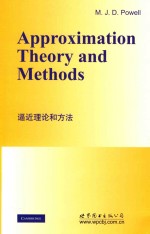

逼近理论和方法PDF电子书下载
- 电子书积分:12 积分如何计算积分?
- 作 者:(英)M· J· D· Powell(M·J·D·鲍威尔)
- 出 版 社:北京/西安:世界图书出版公司
- 出版年份:2015
- ISBN:9787510086250
- 页数:339 页
1 The approximation problem and existence of best approximations 1
1.1 Examples of approximation problems 1
1.2 Approximation in a metric space 3
1.3 Approximation in a normed linear space 5
1.4 The Lp-norms 6
1.5 A geometric view of best approximations 9
2 The uniqueness of best approximations 13
2.1 Convexity conditions 13
2.2 Conditions for the uniqueness of the best approximation 14
2.3 The continuity of best approximation operators 16
2.4 The 1-,2-and ∞-norms 17
3 Approximation operators and some approximating functions 22
3.1 Approximation operators 22
3.2 Lebesgue constants 24
3.3 Polynomial approximations to differentiable functions 25
3.4 Piecewise polynomial approximations 28
4 Polynomial interpolation 33
4.1 The Lagrange interpolation formula 33
4.2 The error in polynomial interpolation 35
4.3 The Chebyshev interpolation points 37
4.4 The norm of the Lagrange interpolation operator 41
5 Divided differences 46
5.1 Basic properties of divided differences 46
5.2 Newton's interpolation method 48
5.3 The recurrence relation for divided differences 49
5.4 Discussion of formulae for polynomial interpolation 51
5.5 Hermite interpolation 53
6 The uniform convergence of polynomial approximations 61
6.1 The Weierstrass theorem 61
6.2 Monotone operators 62
6.3 The Bernstein operator 65
6.4 The derivatives of the Bernstein approximations 67
7 The theory of minimax approximation 72
7.1 Introduction to minimax approximation 72
7.2 The reduction of the error of a trial approximation 74
7.3 The characterization theorem and the Haar condition 76
7.4 Uniqueness and bounds on the minimax error 79
8 The exchange algorithm 85
8.1 Summary of the exchange algorithm 85
8.2 Adjustment of the reference 87
8.3 An example of the iterations of the exchange algorithm 88
8.4 Applications of Chebyshev polynomials to minimax approximation 90
8.5 Minimax approximation on a discrete point set 92
9 The convergence of the exchange algorithm 97
9.1 The increase in the levelled reference error 97
9.2 Proof of convergence 99
9.3 Properties of the point that is brought into reference 102
9.4 Second-order convergence 105
10 Rational approximation by the exchange algorithm 111
10.1 Best minimax rational approximation 111
10.2 The best approximation on a reference 113
10.3 Some convergence properties of the exchange algorithm 116
10.4 Methods based on linear programming 118
11 Least squares approximation 123
11.1 The general form of a linear least squares calculation 123
11.2 The least squares characterization theorem 125
11.3 Methods of calculation 126
11.4 The recurrence relation for orthogonal polynomials 131
12 Properties of orthogonal polynomials 136
12.1 Elementary properties 136
12.2 Gaussian quadrature 138
12.3 The characterization of orthogonal polynomials 141
12.4 The operator Rn 143
13 Approximation to periodic functions 150
13.1 Trigonometric polynomials 150
13.2 The Fourier series operator Sn 152
13.3 The discrete Fourier series operator 156
13.4 Fast Fourier transforms 158
14 The theory of best L1 approximation 164
14.1 Introduction to best L1 approximation 164
14.2 The characterization theorem 165
14.3 Consequences of the Haar condition 169
14.4 The L1 interpolation points for algcbraic polynomials 172
15 An example ot L1 approximation and the discrete case 177
15.1 A useful example of L1 approximation 177
15.2 Jackson's first theorem 179
15.3 Discrete L1 approximation 181
15.4 Linear programming methods 183
16 The order of convergence of polynomial approximations 189
16.1 Approximations to non-differentiable functions 189
16.2 The Dini-Lipschitz theorem 192
16.3 Some bounds that depend on higher derivatives 194
16.4 Extensions to algebraic polynomials 195
17 The uniform boundedness theorem 200
17.1 Preliminary results 200
17.2 Tests for uniform convergence 202
17.3 Application to trigonometric polynomials 204
17.4 Application to algebraic polynomials 208
18 Interpolation by piecewise polynomials 212
18.1 Local interpolation methods 212
18.2 Cubic spline interpolation 215
18.3 End conditions for cubic spline interpolation 219
18.4 Interpolating splines of other degrees 221
19 B-splines 227
19.1 The parameters of a spline function 227
19.2 The form of B-splines 229
19.3 B-splines as basis functions 231
19.4 A recurrence relation for B-splines 234
19.5 The Schoenberg-Whitney theorem 236
20 Convergence properties of spline approximations 241
20.1 Uniform convergence 241
20.2 The order of convergence when f is differentiable 243
20.3 Local spline interpolation 246
20.4 Cubic splines with constant knot spacing 248
21 Knot positions and the calculation of spline approximations 254
21.1 The distribution of knots at a singularity 254
21.2 Interpolation for general knots 257
21.3 The approximation of functions to prescribed accuracy 261
22 The Peano kernel theorem 268
22.1 The error of a formula for the solution of differential equations 268
22.2 The Peano kernel theorem 270
22.3 Application to divided differences and to polynomial interpolation 274
22.4 Application to cubic spline interpolation 277
23 Natural and perfect splines 283
23.1 A variational problem 283
23.2 Properties of natural splines 285
23.3 Perfect splines 290
24 Optimal interpolation 298
24.1 The optimal interpolation problem 298
24.2 L1 approximation by B-splines 301
24.3 Properties of optimal interpolation 307
Appendix A The Haar condition 313
Appendix B Related work and references 317
Index 333
- 《中风偏瘫 脑萎缩 痴呆 最新治疗原则与方法》孙作东著 2004
- 《SQL与关系数据库理论》(美)戴特(C.J.Date) 2019
- 《联吡啶基钌光敏染料的结构与性能的理论研究》李明霞 2019
- 《情报学 服务国家安全与发展的现代情报理论》赵冰峰著 2018
- 《英汉翻译理论的多维阐释及应用剖析》常瑞娟著 2019
- 《新课标背景下英语教学理论与教学活动研究》应丽君 2018
- 《党员干部理论学习培训教材 理论热点问题党员干部学习辅导》(中国)胡磊 2018
- 《虚拟流域环境理论技术研究与应用》冶运涛蒋云钟梁犁丽曹引等编著 2019
- 《当代翻译美学的理论诠释与应用解读》宁建庚著 2019
- 《基于地质雷达信号波的土壤重金属污染探测方法研究》赵贵章 2019
- 《SQL与关系数据库理论》(美)戴特(C.J.Date) 2019
- 《古代巴比伦》(英)莱昂纳德·W.金著 2019
- 《BBC人体如何工作》(英)爱丽丝.罗伯茨 2019
- 《一个数学家的辩白》(英)哈代(G.H.Hardy)著;李文林,戴宗铎,高嵘译 2019
- 《莎士比亚全集 2》(英)莎士比亚著,朱生豪等译 2002
- 《莎士比亚戏剧精选集》(英)威廉·莎士比亚(William Shakespeare)著 2020
- 《莎士比亚 叙事诗·抒情诗·戏剧》(英)威廉·莎士比亚著 2019
- 《亚历山大继业者战争 上 将领与战役》(英)鲍勃·本尼特,(英)麦克·罗伯茨著;张晓媛译 2019
- 《孩子们的音乐之旅 1 宝宝睡觉 幼儿版》包菊英主编 2016
- 《超级参与者》王金强责编;赵磊译者;(澳)杰里米·海曼斯,(英)亨利·蒂姆斯 2020
- 《TED说话的力量 世界优秀演讲者的口才秘诀》(坦桑)阿卡什·P.卡里亚著 2019
- 《小手画出大世界 恐龙世界》登亚编绘 2008
- 《近代世界史文献丛编 19》王强主编 2017
- 《课堂上听不到的历史传奇 世界政治军事名人 初中版》顾跃忠等编著 2015
- 《指向核心素养 北京十一学校名师教学设计 英语 七年级 上 配人教版》周志英总主编 2019
- 《365奇趣英语乐园 世界民间故事》爱思得图书国际企业 2018
- 《近代世界史文献丛编 36》王强主编 2017
- 《北京生态环境保护》《北京环境保护丛书》编委会编著 2018
- 《近代世界史文献丛编 11》王强主编 2017
- 《近代世界史文献丛编 18》王强主编 2017
